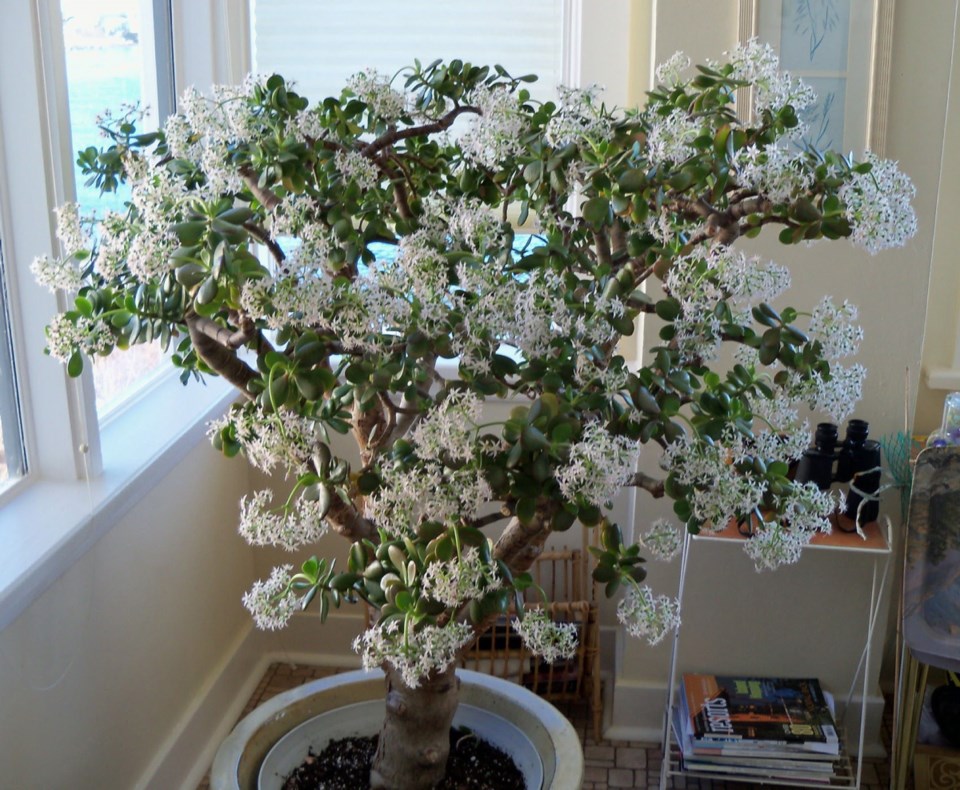A few weeks ago, an intriguing request arrived in the mail. Faced with a downsizing in the near future, Barbara was keen to find a good home for a “large and beautiful” jade plant, “currently in bloom.” A suggestion I offered worked perfectly. The plant’s new owner has space for a large plant, a special fondness for succulents and the expertise to care well for the plant, which has “a history.”
Barbara’s jade plant, now about 135 centimetres tall, was with her for 40 years, and with her mother before that for at least 10 years. Since her move to Victoria 15 years ago, the plant has thrived and blossomed in her sunroom.
Because bloom in jade plants is not all that common, I asked Barbara to outline her care for the plant. In her generously detailed reply, she described jade plants as “easy to grow and hard to kill unless overwatered,” but they need to be mature plants to bloom.
Barbara has observed that the plants need plenty of sunlight. Her plant is kept on her sunny balcony, protected from frost, until autumn, when she moves it to an unheated sunroom, where cool temperatures (10-12 C), bright daytime light, and long, dark nights along with minimal watering prompt bloom early in the year.
From late fall, as her jade plant enters a “resting” period, Barbara waters only every two or three weeks.
And she prunes. After the bloom period, Barbara pinches off flowered stems. During the growing season she removes any leggy or drooping growth. “I prefer the upright form.”
Thanks to Barbara Shields for sharing her hands-on information and for providing photos of her mature jade plant in bloom. She also sent along a picture of a flowering jade plant hedge lining a street in Lisbon, where a friend lives.
Seeding tip. In response to a column that mentioned foliar feeding with seaweed fertilizer, Diane MacRae wrote about the liquid seaweed fertilizer that Reindeer used to make. Her trials with foliar feeding produced surprising results.
When Diane ran out of seeding mix just over a week ago, she went to GardenWorks in Oak Bay, where the staff told her their customers are raving about Reindeer’s “Seed Starter” mix. She is trying it and so far has found it has more body than most seed starter mixes and it absorbs water well. Its ingredients include kelp meal, alfalfa meal, worm castings and other good things, in a base of coconut fibre (coco peat).
Most Buckerfield’s stores carry Reindeer products. Visit reindeersnatural.ca for a list of products and stores that carry them (Click on Links).
GARDEN EVENTS
Peninsula meeting. The Peninsula Garden Club will meet on Monday, March 12, at 7 p.m. in the Mary Winspear Centre in Sidney. Chris Hildreth, founder and CEO of Topsoil, will present Innovative Agriculture: Redefining How We Grow Our Food. Topsoil converts underutilized urban spaces into productive food growing areas. topsoileatlocal.com. Non-member drop-in fee is $5. The meeting includes a parlour show, plant stall, library access.
Lily meeting. The Victoria Lily Society will meet on Wednesday, March 14, at 7 p.m. in the Salvation Army Citadel, 4030 Douglas St. Colin Tamboline will present Where Do Garden Lilies Come From? — a discussion and slide show on species lilies.
Nanaimo meeting. The Nanaimo Horticultural Society will meet on Wednesday, March 14, at 7 p.m. in First Unitarian Fellowship Hall, 595 Townsite Rd. There will be a talk on healthy soils and a parlour show. Information at 250-758-6783.
HCP workshops. The Horticulture Centre of the Pacific, 505 Quayle Rd. in Saanich, is offering the following workshops. To register call 250-479-6162. hcp.ca.
• Plant Identification & Culture. The next session in this ongoing, monthly course (can be joined at any time) will be on Saturday, March 17, 1 to 4 p.m. In each session Diane Pierce introduces 25 new plants, with descriptions, preferred growing conditions, landscape uses and maintenance. Cost to HCP members per session is $35, others $45. Cost for 12 sessions: members $350, others $450.
• Build Your Own Hoop House, Saturday, March 17, 9 a.m. to 12 p.m. Learn about different styles, methods and materials and participate in building a hoop house at HCP.
• Hoop House Irrigation workshop, Saturday, March 17, 1 to 4 p.m. Learn the basics of and practise installing micro/drip irrigation in HCP’s newly built hoop house. Cost for members and others: $45 per hoop house workshop or $75 for both workshops.



